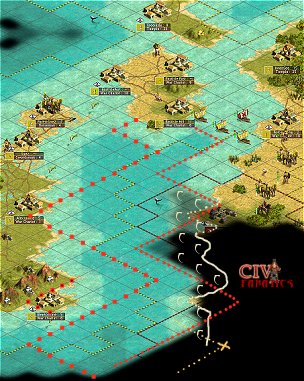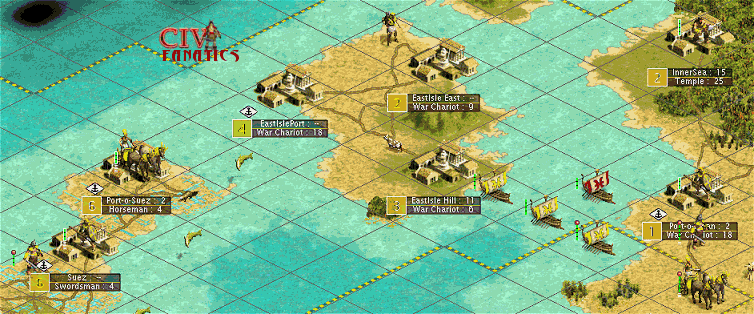 GOTM9 -
Ferry Boat Operations in the Inland Sea
GOTM9 -
Ferry Boat Operations in the Inland Sea
|
GOTM9 Index Items below this point
Known Bugs and Glitches |
The Egyptian homeland was located to the west (far left) of the Japanese military theatre. During the initial year of the war, we knew the Japanese had at least one galley in operation and assumed that they probably had at least two or three more galleys at some location. The galley we knew about had originated way off around by the tip of the Japanese mainland where we had landed our disruptive invasion force. We had watched this galley wander/explore along the northern coast and then head into the gap of the inland sea from the north. It was hard to guess what strategy or tactic that Tokugawa may have been following with this galley, because there were basically no open land locations on any of the islands that rimmed the inland sea due to the forced expansion of the Egyptian empire during the early turns of the timeline. The area was so completely settled that there had been no sign of and barbarian galleys for many, many years. The
Inland Sea as an Egyptian Lake In 210 AD, A look at the shape of the Inland sea, as shown in the image at right, reveals that almost nowhere along the length of the water gap, can a galley possible begin its turn in a port on one side and then end its turn in a port on the opposite side of the sea during the same turn. To help see this fact
more clearly, I have located the estimated location of a second Japanese
potential Japanese port city that appears in the lower left portion of the
map. Then I have used a graphic Only one location on the map could possible support a single turn crossing by galleys with four (4) movement points per turn. This route between the southern Egyptian port city of Elephantine and the barely visible point of Japanese coast directly to its east would not be available early on in the campaign due to the poor relative positioning of the two Japanese towns that can already be seen on the map. From a transportation standpoint, the geometry of the inland sea and the location of the port towns on either side basically meant that the sea was basically 2 moves in width at the beginning of the war. In order to ferry an average of two units across the sea in every turn we needed to have four galleys in the sea on ferrying duty. If we could move down the Japanese coast and take the first Japanese port city, then we could almost double the delivery rate of reinforcements even if our galleys could not individually make the crossing in a single trip.
The opening galley moves The outbreak of hostilities with Japan, made it no longer worthwhile to tolerate the presence of the Japanese galley in the inland sea so I had to weigh the risks of losing a critically important galley from our fleet versus any potential disruption that the Japanese galley might do if it reach a friendly port and loaded up some offensive units to dump onto our undefended homeland or one of our inland sea island outposts. The chances of a veteran galley attacking and defeating a regular galley would only be 57% which was just barely in our favor, but based on this chance of success and the risk of doing nothing I chose to go for it and attack the Japanese galley. Our veteran galley from the center of the blockade line defeated its opponent in three strokes and miraculously escaped without a scratch. This galley immediately dashed to the shore nearby to pick up a settler and then moved one step closer to delivering that settler to unloading at Port-o-Japan at the beginning of the next turn.
The coastal galley on the blockade line had already expended all of its movement points to deliver two units for the reserves for the attack forces near Toyama so it could not move towards picking up a new load. The galley near the East Isle of the inland sea could use three of its move points to return near the Egyptian coast and load a critically needed horseman from Port-o-Suez plus an additional swordsman from Suez to strengthen the attack forces. Once loaded, this galley could gain one step of movement toward unloading on the Japanese continent.
Other related topics:
|
 ©
2002 by cracker@CivFanatics.com
©
2002 by cracker@CivFanatics.com
All rights reserved. Please read the Terms
of Use.
Send mail to our webmaster with technical
questions about or potential problems with this web site.


